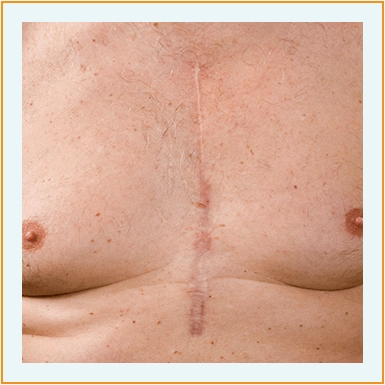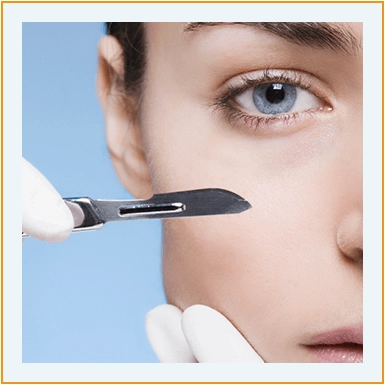Why do scars occur?
Scars are the result of normal wound healing. However, when the healing process is too aggressive, scars can become unsightly and cause discomfort or disability.
Several factors influence how your skin scars: the depth and size of the incision or injury, the location of the wound and also your age, genetic pre-disposition, ethnicity and even gender.
Dermatix® can be used as soon as the wound has healed to reduce the visibility of a scar.2


Types of scars treated by Dermatix®
Hypertrophic scars are raised, red scars that do not extend beyond the wound or injury site.
Keloid scars are raised scars which extend beyond the original wound or injury.

Scar Treatments
The number of options available for treatment of raised scars can at first appear confusing.
Numerous over-the-counter creams, ointments and gels are sold as scar treatments but few have clinically proven effectiveness.4
Many over-the-counter options lack clinical proof of their effect on raised scars.4
Some other treatments are invasive, painful and expensive and include; surgical removal, dermabrasion, steroid injection, laser surgery and skin graft.4,5
Silicone products, however, have been used for over 30 years as a convenient option to treat raised scars.4
Silicone gels such as Dermatix® are considered to be the standard in care for scar reduction.4
Dermatix® contains silicone gel, a clinically proven, transparent gel which:
- Forms a flexible transparent and odourless silicone sheet over scars
- Visibly improves old and new raised scars1 on the face and body, including: hypertrophic and keloid scars resulting from trauma, burns, surgery and other invasive procedures
- Relieves itching and discomfort and reduces the discolouration of scars2
- Is a semi-permeable membrane which acts like an extra layer of skin6
- Helps to flatten, soften and smooth raised scars7,8 while maintaining the moisture balance and elasticity of the adjacent skin2
- Is suitable for use on sensitive skin and can be used on children
- Is a non-painful and non-invasive raised scar treatment
Dermatix® – stages of treatment
CASE: 55 year old female with a 1-2 year old linear hypertrophic scar.




Dermatix® Silicone Gel
- Flattens, softens and smoothes raised scars7,8
- Reduces itching and discolouration associated with raised scars2
- Dermatix® gel is a transparent, convenient, fast-drying formulation which may be applied to all areas of the skin including: face, joints and hair covered areas
- Dermatix® gel is suitable for sensitive skin and is indicated for use in children
Dermatix® Silicone Gel
- Flattens, softens and smoothes raised scars7,8
- Reduces itching and discolouration associated with raised scars2
- Dermatix® gel is a transparent, convenient, fast-drying formulation which may be applied to all areas of the skin including: face, joints and hair covered areas
- Dermatix® gel is suitable for sensitive skin and is indicated for use in children
For what sorts of scars can I use Dermatix® ?
Dermatix® has been proven in clinical trials to visibly improve raised scars.2,3
Dermatix® is indicated for raised scars resulting from: surgery, trauma, burns, laser abrasion and chemical peels.
Common procedures leading to raised scars

Cardiac Surgery

Cosmetic Surgery

Reconstructive Surgery

Caesarean Section
Other procedures or conditions that may lead to raised scars
Cleft lip surgery
Burns
‘Tummy tuck’ surgery
Caesarean delivery
Laser abrasion
Hysterectomy
Chemical peels
Vaccination
Body piercing
Lacerations
Tattoo procedures
Mastectomy
How to use Dermatix®
Apply when the wound has completely healed, and, keep away from the eyes and mucous membranes
Apply every morning and night
Allow to dry for 4-5 minutes before covering with clothing, cosmetics or sunscreen
Apply for a minimum of 2 months
Use alone, it should not be applied over antibiotic skin preparations or other skin treatments or products
Additional scar care
Avoid extreme heat and cold. Avoid tight & irritating clothing
Be careful when stretching & exercising
Purchase Dermatix®

From Pharmacies
Selected Cosmetic/ Plastic Surgeon and Dermatology practices
References: 1. Quinn KJ et al. Burns 1985; 12:102-08. 2. Chan KY Plast Reconstr Surg 2005; 116: 1013-17. 3. Chernoff WG et al. Aesthetic Plast Surg 2007; 31(5): 495-500. 4. Mustoe TA et al. Plast Reconstr Surg 2002; 110: 560-571. 5. Valeant Pharmaceuticals International. Dermatix Monograph 2007: 22. 6. Atkinson JM. Plast and Reconst Surg 2005; 116(6): 1648-56. 7. Fulton JE. Dermatol Surg 1995; 21: 947-51. 8. Perkins K et al. Burns 1982; 9:201.
Always read the label. Follow directions for use. If symptoms persist, talk to your health professional.
AU-2019-11-0044
Contact Us
Customer Service & Product Distribution
For general enquiries and enquiries on product availability,
free call 1800 630 056 (Select option 1)(Australia Only).
F: 1800 119 266 E: customerservice@inovapharma.com
Medical Communications & Drug Safety
For medical enquiries regarding iNova products
free call 1800 630 056 (Select Option 4)(Australia Only).
(Outside Australia) E: medical@inovapharma.com



